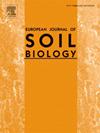轮作和有机肥可维持复垦煤矿土壤中携带cbbl的co2固定细菌的多样性和活性
IF 3.3
2区 农林科学
Q1 ECOLOGY
引用次数: 0
摘要
固结菌是恢复矿区土壤健康的重要因子。轮作和施肥对复垦矿区土壤中固定co2细菌的影响尚不清楚。为了缩小这方面的知识差距,本研究在某煤矿垦区建立了玉米(Zea mays L.)单作(M)和玉米-大豆(Glycine max)轮作(R)制度,每种施肥处理分别为CK(不施肥)、无机肥(F)、有机肥(O)和有机无机复合肥(OF)。采用定量PCR、基于cbbL基因(编码核酮糖-1,5-二磷酸羧化酶/加氧酶(RubisCO))的高通量测序和酶联免疫吸附试验(ELISA)分别研究了不同处理下表层土壤co2固定菌的丰度、多样性、群落组成和RubisCO活性。结果表明:R_O显著提高了易氧化有机碳(EOC)、总氮(TN)和速效氮(AN) (P <;0.05)。它还显著增加了co2固定菌的生物量(P <;0.05),并改变了固定co2的细菌群落。与其他处理相比,R_OF、R_O和M_O的co2固定菌群落结构相似,共发生网络复杂性更高。玉米-大豆轮作制度下,与氮循环相关的几种co2固定菌,如Devosia、Nitrobacter、菌丝微生物和亚硝基螺旋体显著富集(P <;0.05)。本研究表明,轮作与有机肥施用可通过提高土壤养分、维持携带cbbl的co2固定菌的生物量、多样性和群落结构,协同促进矿区土壤质量恢复,为优化采煤后生态恢复固碳策略奠定理论基础。本文章由计算机程序翻译,如有差异,请以英文原文为准。
Crop rotation and organic fertilizer maintains diversity and activity of cbbL-carrying CO2-fixing bacteria in reclaimed coal mining soils
CO2-fixing bacteria are an important factor in restoring soil health in coal mining areas. The impact of crop rotation and fertilization on CO2-fixing bacteria in reclaimed mining soils remains unclear. To narrow this knowledge gap, in this study, maize (Zea mays L.) monoculture (M) and maize-soybean (Glycine max) rotation (R) cropping systems were set up in a coal-mining reclamation area with four fertilization treatments in each, namely, CK (without fertilization), inorganic fertilizer (F), organic fertilizer (O), and combined organic and inorganic fertilizer (OF). The abundance, diversity, community composition and RubisCO activity of CO2-fixing bacteria in topsoil under those treatments were investigated respectively using quantitative PCR, high-throughput sequencing based on the cbbL gene [that encodes ribulose-1,5-biphosphate carboxylase/oxygenase (RubisCO)] and enzyme-linked immunosorbent assay (ELISA). The results showed that R_O significantly increased easily oxidized organic carbon (EOC), total nitrogen (TN), and available nitrogen (AN) (P < 0.05). It also significantly increased the biomass of CO2-fixing bacteria (P < 0.05) and altered the CO2-fixing bacterial community. The CO2-fixing bacteria in R_OF, R_O and M_O exhibited comparable community structures and harbored a greater co-occurrence network complexity than other treatments. Several CO2-fixing bacteria associated with nitrogen cycling, such as Devosia, Nitrobacter, Hyphomicrobiales and Nitrosospira, were significantly enriched under the maize-soybean rotation system (P < 0.05). This study implied that crop rotation and organic fertilizer application could synergistically foster soil quality restoration in coal mining area by elevating soil nutrients and maintaining biomass, diversity and community structure of cbbL-carrying CO2-fixing bacteria, establishing a theoretical foundation for optimizing carbon sequestration strategies in post-mining ecological rehabilitation.
求助全文
通过发布文献求助,成功后即可免费获取论文全文。
去求助
来源期刊

European Journal of Soil Biology
环境科学-生态学
CiteScore
6.90
自引率
0.00%
发文量
51
审稿时长
27 days
期刊介绍:
The European Journal of Soil Biology covers all aspects of soil biology which deal with microbial and faunal ecology and activity in soils, as well as natural ecosystems or biomes connected to ecological interests: biodiversity, biological conservation, adaptation, impact of global changes on soil biodiversity and ecosystem functioning and effects and fate of pollutants as influenced by soil organisms. Different levels in ecosystem structure are taken into account: individuals, populations, communities and ecosystems themselves. At each level, different disciplinary approaches are welcomed: molecular biology, genetics, ecophysiology, ecology, biogeography and landscape ecology.
 求助内容:
求助内容: 应助结果提醒方式:
应助结果提醒方式:


